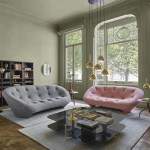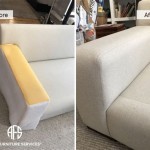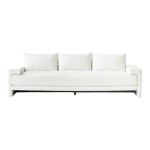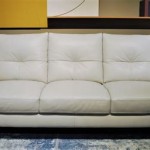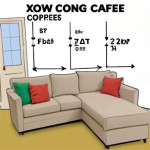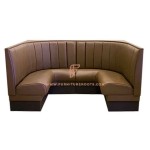Back Cushion: Enhancing Sofa Comfort and Support
Sofas are often central pieces of furniture in homes and offices, providing seating for relaxation, conversation, and entertainment. However, the comfort and ergonomic support offered by a sofa can be significantly influenced by the quality and design of its back cushions. Back cushions not only contribute to the aesthetic appeal of a sofa but also play a crucial role in maintaining proper posture and alleviating discomfort during prolonged sitting.
A well-chosen back cushion can transform a simple sofa into a haven of relaxation, while an inadequate one can lead to back pain, fatigue, and poor posture. Understanding the various types of back cushions available, their materials, and their impact on comfort and support is essential for selecting the right cushions to enhance the overall sofa experience.
This article will explore the different facets of back cushions for sofas, focusing on the types available, the materials used in their construction, and their impact on comfort and support. It will also delve into factors to consider when choosing back cushions that best suit individual needs and preferences.
Understanding Different Types of Back Cushions
Back cushions for sofas come in a variety of types, each designed to offer a unique level of support and aesthetic appeal. The type of back cushion can greatly influence the overall feel and look of the sofa. Common types include loose cushions, attached cushions, and scatter cushions. Each type has its own advantages and disadvantages, making them suitable for different sofa styles and seating preferences.
Loose Cushions: Loose back cushions are independent of the sofa frame, allowing for flexible arrangement and easy removal for cleaning or replacement. These cushions are versatile and can be rearranged for customized support. They are often filled with materials such as feathers, down, fiberfill, or foam, each offering a different level of firmness and comfort. Loose cushions are commonly found in more casual sofa styles and can add a relaxed and inviting feel to the seating area.
The advantage of loose cushions lies in their adaptability. They can be rotated to even out wear and tear, and their fillings can be adjusted or replaced to maintain their shape and support. However, loose cushions may require more maintenance as they can shift and lose their shape over time, necessitating frequent fluffing and rearranging.
Attached Cushions: Attached back cushions are sewn directly onto the sofa frame, providing a more structured and stable support system. These cushions typically maintain their shape better than loose cushions and require less maintenance. They are commonly found in more formal sofa styles and offer a clean, tailored look. The filling materials for attached cushions are usually similar to those used in loose cushions, but they are often more densely packed to provide firmer support.
Attached cushions offer the benefit of consistent support and a neat appearance. However, their fixed nature limits flexibility in terms of arrangement and customization. If an attached cushion becomes damaged or worn, it may be more difficult and costly to repair or replace compared to a loose cushion.
Scatter Cushions: Scatter cushions are smaller, decorative cushions that are often used in conjunction with either loose or attached back cushions. They serve both aesthetic and functional purposes, adding layers of comfort and visual appeal to the sofa. Scatter cushions come in a wide range of shapes, sizes, and fabrics, allowing for endless customization options. They can be used to provide additional lumbar support or simply to enhance the overall look of the seating area.
Scatter cushions provide an opportunity to personalize a sofa and add pops of color, texture, and pattern. They can be easily changed to reflect seasonal trends or personal style preferences. However, too many scatter cushions can clutter the sofa and make it less comfortable to sit on.
Exploring Materials Used in Back Cushion Construction
The materials used in the construction of back cushions significantly impact their comfort, durability, and overall performance. Common filling materials include feathers, down, fiberfill, and foam, each possessing distinct properties that cater to different preferences and needs. The choice of filling material should consider factors such as support level, softness, and maintenance requirements.
Feather and Down: Feather and down fillings offer a luxurious and soft feel, conforming to the body's shape and providing excellent comfort. Down is the soft undercoating of waterfowl, while feathers are the outer plumage. A combination of both is often used in back cushions, with a higher down content resulting in a softer and more plush feel. Feather and down cushions require regular fluffing to maintain their shape and prevent clumping.
The advantage of feather and down cushions is their exceptional comfort and ability to mold to the body. However, they may not provide as much support as other filling materials, and they can be more expensive and require more maintenance. Additionally, feather and down may not be suitable for individuals with allergies.
Fiberfill: Fiberfill, typically made from polyester fibers, is a synthetic alternative to feather and down. It is hypoallergenic, relatively inexpensive, and requires less maintenance than natural fillings. Fiberfill cushions are available in a range of densities, offering varying levels of firmness and support. They are a popular choice for individuals seeking a balance between comfort and practicality.
Fiberfill cushions are easy to care for and offer good value for money. However, they may not be as soft or luxurious as feather and down cushions, and they can flatten over time with prolonged use. High-quality fiberfill can better retain its shape and provide more consistent support.
Foam: Foam fillings offer a firm and supportive feel, making them ideal for individuals who require good lumbar support. Foam cushions are available in various densities and types, including polyurethane foam, memory foam, and latex foam. Polyurethane foam is a common and affordable option, while memory foam conforms to the body's shape and provides pressure relief. Latex foam is a natural and durable option that offers good support and breathability.
Foam cushions provide excellent support and maintain their shape well. However, they may not be as soft or conforming as feather and down fillings. Memory foam can become warm during prolonged use, while latex foam offers better breathability. The density of the foam determines its firmness and support level, with higher-density foams providing firmer support.
Combination Fillings: Some back cushions utilize a combination of different filling materials to achieve a desired balance of comfort and support. For example, a cushion may be filled with a core of foam for support and wrapped in a layer of down for softness. These combination fillings can offer the benefits of multiple materials while minimizing their drawbacks.
Impact on Comfort, Support, and Ergonomics
The design and materials of back cushions directly influence the comfort, support, and ergonomic benefits provided by a sofa. Properly designed back cushions promote good posture, alleviate pressure points, and reduce the risk of back pain. The height, depth, and angle of the cushions, as well as the firmness and support level of the filling material, all contribute to the overall ergonomic performance of the sofa.
Lumbar Support: Adequate lumbar support is essential for maintaining proper spinal alignment and preventing lower back pain. Back cushions that provide targeted lumbar support help to fill the natural curve in the lower back, reducing strain on the muscles and ligaments. This can be achieved through the use of shaped cushions, adjustable cushions, or cushions with built-in lumbar support features.
Insufficient lumbar support can lead to slouching and poor posture, which can exacerbate existing back problems or contribute to the development of new ones. Choosing back cushions with adequate lumbar support is particularly important for individuals who spend extended periods sitting on the sofa.
Pressure Relief: Back cushions should distribute weight evenly and minimize pressure points to enhance comfort and prevent discomfort. Cushions filled with materials such as memory foam or down conform to the body's shape and reduce pressure on sensitive areas. This can be particularly beneficial for individuals with back pain or pressure sensitivity.
Cushions that are too firm or lack adequate padding can create pressure points and cause discomfort during prolonged sitting. Selecting cushions with appropriate padding and contouring can significantly improve overall comfort and reduce the risk of pain and fatigue.
Posture and Alignment: Back cushions should promote proper posture and spinal alignment to reduce strain on the back and neck. Cushions that are too soft or lack adequate support can lead to slouching, while cushions that are too firm can force the spine into an unnatural position. The ideal back cushion should provide a balance of support and cushioning to maintain a healthy posture.
Proper posture is essential for overall health and well-being. Maintaining good posture while sitting on the sofa can reduce the risk of back pain, neck pain, headaches, and other musculoskeletal problems. Choosing back cushions that support proper posture is an investment in long-term health and comfort.
Cushion Placement and Arrangement: The placement and arrangement of back cushions can also impact comfort and support. Adjusting the position of cushions can help to optimize lumbar support, pressure relief, and overall posture. Experimenting with different arrangements can help to find the most comfortable and supportive configuration.
For example, placing a small lumbar cushion behind the lower back can provide additional support and alleviate pressure. Arranging scatter cushions strategically can also enhance comfort and visual appeal. The optimal cushion arrangement will vary depending on individual preferences and the specific design of the sofa.

How Sofa Back Cushions Affect Your Comfort Couch On

How Sofa Back Cushions Affect Your Comfort The Stated Home Blog

Sofa Back Cushions Futon Company

Wool Seat And Back Couch Cushions All Natural Free Of

How To Fix Sagging Couch Cushions Thistlewood Farm

Asjhk Sofa Bed Large Triangular Cushion Three Dimensional Tatami Daybed Backrest Double Soft Bag Reading Back C Headboard Design Bedroom Decor

Back Cushion To Sofa August Gray Manufactum

Replacement Couch Pillows Bring Life Back To Your Old

Camargue Additional Back Cushion For Modular Sofa

Soft Knot Throw Pillow Knitted Back Cushion Sofa Nordic Home Room Decor Gift

